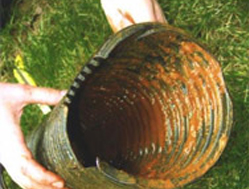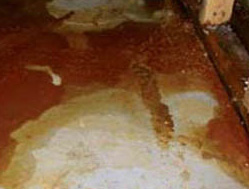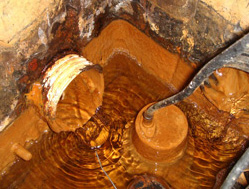
Ferrous and iron ochre removal in Montreal and surroundings
Ferrous ocher (iron ochre removal) is a reddish muddy deposit resulting from the bacterial activity of iron present naturally in soils and groundwater. When the concentration of these bacteria is high, a reddish jelly is produced, composed of 90% water, which can clog the perforated drains surrounding the foundations of residences and the pumping wells in the basement. Clogged drains can cause water to seep into the basement. Drainage Québécois stands at the top of the list for the diversity and quality of its equipment. Each vehicle is equipped with a location camera, a smoke test, fichoirs, as well as pressure equipment.
The solution for iron ocher is complex
It is very difficult to eliminate iron since it is present naturally in the soil. Even replacing the soil around the building, the iron from the surrounding soils would again migrate to the property drain through natural water runoff. To prevent the development of the bacterium, it would be necessary to remove from the soil the two natural elements of water and air, which is impossible. It is therefore unthinkable to prevent the chemical reaction that creates ferrous ocher (ferrous ocher solution). However, Drainage Québécois has a solution to this problem.
We have a solution to your iron ochre!
Can iron ocher be prevented after construction? Be vigilant if there are warning signs such as a high level of humidity in the basement, a recent flood or the presence of reddish water in the ditches or on the surface after a rain. Possible fixes to existing buildings to alleviate iron ocher symptoms vary by location.
- The change in the slope of the ground
- Sealing at the junction of the concrete wall and the concrete slab
- Place cleaning chimneys
- Drainage under the slab
- Applying a water-repellent coating
- Installation of a waterproofing membrane
- Raising the basement slab
- Elimination of the basement.
Here is more information on iron ocher to find out if you are a victim of it.
How does iron ocher manifest itself?
Development of this material is more likely in looser soil, such as sandy soils containing silt, and less likely in clay soil.
The chemical or biological reaction is also faster:
- Where the soil is rather neutral (pH around 7)
- When the drain is grooved
- When drain openings are punched instead of cut out, giving deposits more grip
- When the drain is wrapped in a membrane filter.
Under the action of iron ochre, even crushed gravel loses its filtering properties. Soils rich in iron and ferrobacteria will produce iron deposits indefinitely.
What are the consequences of the presence of iron ocher (iron ochre removal and solution)?
Iron ocher causes several problems affecting buildings. Indeed, she:
- Causes slimy, ocher-colored mud deposits to appear in the stormwater catchment basin and in the ditches
- Creates reddish deposits on the concrete slab of basements. These deposits emit odors reminiscent of sulfur
- Blocks agricultural drains: the runoff water is no longer channeled far from the foundations, it infiltrates into the basements, at the junction of the foundation walls and the slab
- Blocks the non-return valves.
Can we eliminate iron ocher or prevent the development of the bacteria?
Iron is naturally present in the soil. It is therefore very difficult to eliminate it. Even replacing the soil around the building, the iron from the surrounding soils would again migrate to the property drain through natural water runoff.
To prevent the development of the bacterium, it would be necessary to remove from the soil the two natural elements of water and air, which is impossible. It is therefore not possible to prevent the chemical reaction that creates ferrous ocher (ferrous ocher solution).




